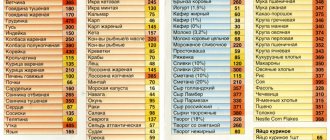© rummess — depositphotos.com
Share:
We all know the main principle of achieving progress in sports. 40% training, 20% sleep, and 40% nutrition. But how to calculate nutrition correctly to achieve certain goals? Of course, a plan is drawn up for this, which takes into account physical and mental needs and expenses. But from this entire formula, one single factor drops out, which will be discussed in the next material - basal metabolism.
What it is
Basic metabolism is one of the indicators of the intensity of metabolism and energy in the human body. It is determined by the amount of fasting energy in optimal temperature conditions, which is necessary to maintain a state of complete physical and mental peace.
That is, basal metabolism shows how much energy the body spends to maintain the constant activity of internal organs and muscles.
The energy that the body receives as a result of such reactions is used to ensure a constant body temperature (source - Textbook “Physiology of Metabolism and the Endocrine System”, Tepperman).
Thanks to the completeness of basal metabolism, the following is ensured:
- Synthesis of basic hormones.
- Synthesis of basic enzymes.
- Providing basic cognitive function.
- Digestion of food.
- Dream.
- Maintaining immune function.
- Maintaining the ratio of anabolic to catabolic processes.
- Maintaining respiratory functions.
- Transportation of basic energy elements by blood.
- Maintaining a constant body temperature according to Rubner's law.
And this is not a complete list of what is happening in our body. In particular, even when a person sleeps, most of the processes, albeit in a slow manner, help synthesize new building elements and break down glycogen into glucose. All this requires a constant supply of calories, which a person gets from food. In particular, this basic consumption is the daily minimum norm of how many calories are needed to maintain basic body functions.
BMR Calculator
Basal Metabolic Rate Calculator or BMR Calculator is a tool that lets you know the minimum amount of energy your body needs to stay alive. Basal metabolic rate is the basal metabolic rate, mainly dependent on lean body mass. Calculating your BMR is important because if you don't know the least amount of calories your body needs, you may become tired and sluggish. Your body will not perform its basic functions. So understand BMR better by using this Basal Metabolic Rate calculator.
Rubner surface
Oddly enough, sometimes metabolism is determined not only by biochemical processes, but also by simple physical laws.
Scientist Rubner discovered a relationship linking the total surface area with the number of calories expended.
How does it actually work? There are 2 main factors due to which his assumption turned out to be correct.
- 1st – the size of the organism. The larger the body surface, the larger the organs, and the greater the leverage in any action, which drives a larger “machine” that consumes “more fuel.”
- 2nd – keeping warm. For the normal functioning of the body, metabolic processes occur with the release of heat. In particular, for a person it is 36.6. Moreover, the temperature (with rare exceptions) is evenly distributed throughout the body. So, to heat a larger area, you need more energy. It all has to do with thermodynamics.
Therefore, from all this we can conclude:
Thick people actually spend more energy during their basal metabolic rate. Tall people are often thin due to a caloric deficit caused by an increased basal metabolism and spending on maintaining temperature over a larger body area.
© designer491 — depositphotos.com. One of the formulas for calculating basic exchange
Increase in basal metabolism
To lose weight and gain a slim, beautiful figure or simply switch to a healthy lifestyle, you need to increase your OO indicators. For this:
- Play sports. Such activities burn a lot of calories;
- Drink more water (about three liters per day). It really helps you lose weight, but watch the quality of your drink;
- Eat healthy foods that need to be taken according to the schedule. At the same time, metabolic processes will certainly increase. If you want to lose weight, your calorie intake should be reduced. But don’t “overdo it” with this, because a constant feeling of hunger is also bad;
- Get a massage. Cellular metabolism will “launch its mechanisms” at a different level, and all this will have a great effect on increasing OO;
- Your thoughts should only be positive. This also has a beneficial effect on basic metabolism, because due to bad thoughts and stress, the hormone cortisol is released, and it floods with water, this does not have a very good effect on the figure;
- Regulate your sleep. Give yourself enough rest;
- Go to the bathhouse more often. Visiting the sauna will only benefit your health; in addition, you get rid of excess water in the body;
- Walk more in the fresh air. This will have a positive effect on the functioning of all your organs and your condition in general.
In one of our articles, we wrote in detail about how to speed up your metabolism. Ask questions and leave comments under the article.
Factors determining basal metabolism
The initial intensity of basal metabolism in men weighing about 70 kg is on average 1700 kcal. For women, these parameters are 10% less (source - Wikipedia).
If we consider the level of basal metabolism as a dynamic system, mobile, then there are factors that determine the basic background and the amount of energy distributed:
- Amount of incoming energy. The more frivolous a person is with his diet (constant excess of calories, frequent snacks, acceleration of metabolism), the more actively the body spends them even in passive mode. All this leads to constant hormonal levels and a general increase in the load on the body, and, as a result, faster failure of individual systems.
- The presence of artificial stimulants of metabolic rate. For example, people who drink caffeine have a lower basal metabolic rate when they quit caffeine. At the same time, their hormonal system begins to fail.
- General human mobility. So, during sleep, the body transports glucose from the liver to the muscles, synthesizes new amino acid chains, and synthesizes enzymes. The amount (and, therefore, resources) spent on these processes directly depends on the overall load on the body.
- Change in basal metabolic rate. If a person has brought himself out of balance (natural speed), then the body will spend additional energy on restoring and stabilizing all processes. Moreover, this applies to both acceleration and deceleration.
- Presence of external factors. A change in temperature will force the skin to intensively release heat to maintain the overall temperature, which can change the dynamic factor affecting the overall level of basal metabolism.
- The ratio of absorbed and excreted nutrients. With a constant excess of calories, the body can simply refuse extra nutrients, in this case, basal waste will increase due to the process of converting useful nutrients into transport slag.
In addition, it is worth highlighting the main end products of metabolism, which are excreted from the body regardless of its speed.
Why do you need to maintain the BZHU ratio?
Many clients have a question: why do you need to maintain the ratio of proteins, fats and carbohydrates? Isn't it enough to simply stick to your daily caloric needs to maintain a healthy weight or adjust your body weight?
Everything needs balance, and proper nutrition too. A lot depends on the distribution of nutrients. So, for example, when losing weight, it is necessary to slightly increase the amount of proteins, while reducing the amount of carbohydrates. However, a high-protein diet should be followed for no longer than a month.
Any restrictive diets have a bad effect on the body, because each nutrient has its own functions and tasks. Carbohydrates are our energy reserves and food for the brain. Fats ensure normal functioning of the hormonal system, help absorb fat-soluble vitamins, and maintain healthy skin, hair and nails.
Proteins are the building material for muscles and tissues. The more muscle mass a person has, the faster his metabolism, the easier it is for him to lose weight, and there is less room for fat deposits.
However, we must remember that proteins, fats and carbohydrates are also different. Thus, animal proteins, unlike plant proteins, contain a full range of essential amino acids and are better absorbed by our body.
Simple carbohydrates in large quantities are harmful to us, as they are very high in calories and contribute to surges in glucose and insulin levels in the blood. But complex ones, on the contrary, are useful and help in weight correction.
Hydrogenated and trans fats are harmful and dangerous to health, as they increase the level of bad cholesterol in the blood, contributing to the development of atherosclerosis (blockage of blood vessels with cholesterol plaques).
Saturated lipids should be consumed in limited quantities, but the right fats (poly and monounsaturated fatty acids) are beneficial - they help you lose weight, reduce bad cholesterol, improve brain function and intellectual activity.
So when compiling a diet, you need to give preference to light proteins (animal and plant origin), complex carbohydrates and the right fats. In this case, the menu will include a variety of vegetables, fruits and berries, whole grain porridge, bread and pasta made from durum wheat, lean meat (chicken and turkey fillet, rabbit, quail), fish, seafood, eggs, low-fat dairy and fermented milk dishes, nuts and dried fruits.
What is it regulated by?
Now we need to determine not only what the main energy is spent on during general metabolism, but also how the amount of energy expended is regulated.
- First, there is the initial metabolic rate, which is defined as the ratio of total mobility to the presence of excess energy.
- Secondly, basal metabolism is regulated by the initial level of hormones in the blood. For example, for diabetics or for people suffering from gastrointestinal problems, the overall metabolism will differ in speed and, accordingly, in costs from the average.
- Thirdly, age. As we get older, our basal metabolism slows down as we optimize our body's resources in an attempt to extend the lifespan of our core systems longer. This also includes height and initial body weight, since basal metabolism is dependent on these parameters.
- Plenty of oxygen. Without the oxidation of complex polysaccharides to the level of simple monosaccharides, the release of energy is impossible. More precisely, the mechanism of its isolation changes. With a large amount of oxygen, the rate of excretion increases, which also increases the cost of basic metabolism. At the same time, in conditions of lack of oxygen, the body can switch to burning fat tissue, which is radically different in speed and cost.
- Seasonality. It has been proven that in spring and early summer the basal metabolism is increased, and in winter and late autumn metabolic processes slow down.
- Nature of nutrition. Food and its subsequent digestion increase basal metabolism, especially if proteins predominate in the diet. This effect of food on the rate of basal metabolism is called the “specific dynamic effect of food . Restriction of nutrition or its excess, the concentration of various nutrients in the diet directly affects the rate of basal metabolism (source - Textbook “Physiology of Metabolism and the Endocrine System”, Tepperman).
Continuing the analogy with cars, this is a reduction in speed in order to reduce oil consumption in the engine, and, accordingly, reduce overall engine wear, thereby extending the life of an individual spare part.
Calculation of the ratio of BZHU for proper nutrition
Nutritional balance depends on the correct ratio of BZHU. Depending on the client's goals, the distribution of proteins, fats and carbohydrates will be different. When calculating, rely on the following indicators:
With normal body weight, the BZHU ratio should be 15-18%/30%/52-55%.
To correct weight, the BZHU ratio should be 25%/30%/45%.
The last option for the distribution of BJU is typical for a high-protein diet, which should be followed for only 3-4 weeks, and then you need to switch to a normal ratio of nutrients.
To convert percentages into grams, you must use the indicator of daily calorie needs - SPC (the calculation formula is given above) or the calculated caloric content of the diet for weight correction (menu with reduced or increased energy value). In this case, the SPK will be taken as 100%.
Also keep in mind that the breakdown of 1 g of protein releases 4.1 kcal of energy, 1 g of fat - 9.3 kcal, 1 g of carbohydrates - 4.1 kcal.
To make it clear to you how to count, we will give a clear example:
Let's assume that the client's BAC is 2400 kcal, he wants to lose weight, so the calorie content of his diet needs to be reduced by about 400 kcal. When creating a menu for 2000 kcal, keep in mind that every day this person should receive 500 kcal from proteins (25% of 2000 kcal), 600 kcal from fat (30% of 2000 kcal) and 900 kcal from carbohydrates (45% of 2000 kcal).
Now let’s calculate how much protein, fat and carbohydrates the client needs to consume in grams to meet the given parameters:
- proteins – 121 g (500/4.1);
- fat – 64.5 g (600/9.3);
- carbohydrates – 219.5 g (900/4.1).
By following this example, you can easily calculate the BJU ratio for any person, including yourself and your family members.
Disturbance of balance
The calculation of basal metabolism takes into account dynamic stress. For example, playing sports throws the body out of balance, forcing it to gradually speed up its metabolism and completely adapt to new conditions. This, in turn, causes counteraction (which is characterized by a large loss of nutritional potential, and, possibly, the removal of most body systems from normal mode for some time).
In addition, to regulate the effects of stress, the costs of maintaining the emotional background increase. Well, plus, if the balance is completely restored, the body begins to completely adapt to the new regime with a new metabolic rate.
For example, a sudden change in diet, followed by a slowdown in metabolism, is also a sufficient factor for changing the level of basic consumption. When the system is taken out of balance, it will tend towards it. This determines the current levels of enzymes and hormones.
© sunabesyou — depositphotos.com
Formulas for calculating basic needs
The formula for calculating basal metabolic rate is imperfect. It does not take into account factors such as:
- Individual metabolic rate.
- The ratio of subcutaneous and deep fat.
- Presence of glycogen depot.
- External temperature.
However, for a general estimate, this formula will do. Before the table we insert clarifications:
- BW – body weight. For the most accurate calculation, it is better to use pure weight (excluding adipose tissue).
- R – height. It is used in the formula because of Rubner's theorem. It is one of the most inaccurate coefficients.
- The free coefficient is a magic number that adjusts your result to the norm, once again proving that without such a coefficient (individual for each case), it will not be possible to obtain an adequate calculation of basal metabolism.
| Floor | Age | The equation |
| M | 10—18 | 16.6 mt + 119Р + 572 |
| AND | 10—18 | 7.4 MT + 482R + 217 |
| M | 18—30 | 15.4 MT + 27R + 717 |
| AND | 18—30 | 13.3 MT + 334R + 35 |
| M | 30—60 | 11.3 mt + 16Р + 901 |
| AND | 30—60 | 8.7 MT + 25R + 865 |
| M | >60 | 8.8 MT + 1128Р — 1071 |
| AND | >60 | 9.2 MT + 637R – 302 |
It is important to understand that the calculation formula does not take into account the unevenness of caloric expenditure throughout the day. So, for example, during the day during a meal or after a workout, accelerated metabolism forces the body to consume more energy, even if it does not use it so rationally. While in sleep, metabolic processes are optimized to the maximum, which allows you to achieve optimal results in your goals.
General metabolism
Naturally, the main stages and processes occurring in the body during basic metabolism are not the only expenses. When creating a nutrition plan, say, for weight loss, you need to perceive basal metabolism not as a constant (calculated using a formula), but as a dynamic system, any change in which leads to a change in the calculations.
Firstly, in order to consume the full calorie intake, you need to include in the list of caloric expenditures for all actions performed.
Note: The calculation of a person’s motor and mental needs was discussed in more detail in the article “How to create a calorie deficit?”
Secondly, a change in metabolic rate that occurs precisely during physical activity, or lack thereof. In particular, the emergence of a protein and carbohydrate window after training stimulates not only an acceleration of metabolism, but also a change in the body’s expenditure on digestion. At this time, basal metabolism increases by 15-20%, albeit in the short term, not counting other needs.










